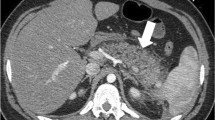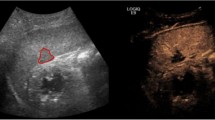Abstract
The most widely used trauma injury grading system is the Organ Injury Scale (OIS) by the American Association for the Surgery of Trauma (AAST). The AAST OIS for renal trauma was revised in 2018 to reflect necessary updates based on decades of experience with computed tomography (CT)–based injury diagnosis and, specifically, to better incorporate vascular injuries, which were not comprehensively addressed in the original OIS. In this review article, we describe CT findings of the AAST OIS for the kidney according to the 2018 revision, with an emphasis on real-world application, and highlight important differences from the prior grading scheme. Routine use of this grading system allows for a standardized classification of the range of renal injuries to aid in management, adding value in the imaging care of trauma patients.







Similar content being viewed by others
References
Moore EE, Shackford SR, Pachter HL, McAninch JW, Browner BD, Champion HR, Flint LM, Gennarelli TA, Malangoni MA, Ramenofsky ML et al (1989) Organ injury scaling: spleen, liver, and kidney. J Trauma 29(12):1664–1666
Moore EE, Cogbill TH, Jurkovich GJ, Shackford SR, Malangoni MA, Champion HR (1995) Organ injury scaling: spleen and liver (1994 revision). J Trauma 38(3):323–324
Chiron P, Hornez E, Boddaert G, Dusaud M, Bayoud Y, Molimard B, Desfemmes FR, Durand X (2016) Grade IV renal trauma management. A revision of the AAST renal injury grading scale is mandatory. Eur J Trauma Emerg Surg : official publication of the European Trauma Society 42(2):237–241. https://doi.org/10.1007/s00068-015-0537-5
Lee YJ, Oh SN, Rha SE, Byun JY (2007) Renal trauma. Radiol Clin N Am 45(3):581–592, ix. https://doi.org/10.1016/j.rcl.2007.04.004
Santucci RA, JW MA, Safir M, Mario LA, Service S, Segal MR (2001) Validation of the American Association for the Surgery of Trauma organ injury severity scale for the kidney. J Trauma 50(2):195–200
Buckley JC, McAninch JW (2011) Revision of current American Association for the Surgery of Trauma Renal Injury grading system. J Trauma 70(1):35–37. https://doi.org/10.1097/TA.0b013e318207ad5a
Kozar RA, Crandall M, Shanmuganathan K, Zarzaur BL, Coburn M, Cribari C, Kaup K, Schuster K, Tominaga GT, Committee APA (2018) Organ injury scaling 2018 update: spleen, liver, and kidney. J Trauma Acute Care Surg 85(6):1119–1122. https://doi.org/10.1097/TA.0000000000002058
Santucci RA, Wessells H, Bartsch G, Descotes J, Heyns CF, McAninch JW, Nash P, Schmidlin F (2004) Evaluation and management of renal injuries: consensus statement of the renal trauma subcommittee. BJU Int 93(7):937–954. https://doi.org/10.1111/j.1464-4096.2004.04820.x
Alonso RC, Nacenta SB, Martinez PD, Guerrero AS, Fuentes CG (2009) Kidney in danger: CT findings of blunt and penetrating renal trauma. Radiographics 29(7):2033–2053. https://doi.org/10.1148/rg.297095071
Erlich T, Kitrey ND (2018) Renal trauma: the current best practice. Ther Adv Urol 10(10):295–303. https://doi.org/10.1177/1756287218785828
Bernath AS, Schutte H, Fernandez RR, Addonizio JC (1983) Stab wounds of the kidney: conservative management in flank penetration. J Urol 129(3):468–470
Hanna TN, Shuaib W, Han T, Mehta A, Khosa F (2015) Firearms, bullets, and wound ballistics: an imaging primer. Injury 46(7):1186–1196. https://doi.org/10.1016/j.injury.2015.01.034
Ersay A, Akgun Y (1999) Experience with renal gunshot injuries in a rural setting. Urology 54(6):972–975
Alsikafi NF, Rosenstein DI (2006) Staging, evaluation, and nonoperative management of renal injuries. Urol Clin 33(1):13–19
Bonatti M, Lombardo F, Vezzali N, Zamboni G, Ferro F, Pernter P, Pycha A, Bonatti G (2015) MDCT of blunt renal trauma: imaging findings and therapeutic implications. Insights Imaging 6(2):261–272. https://doi.org/10.1007/s13244-015-0385-1
Kawashima A, Sandler CM, Corl FM, West OC, Tamm EP, Fishman EK, Goldman SM (2001) Imaging of renal trauma: a comprehensive review. Radiographics 21(3):557–574. https://doi.org/10.1148/radiographics.21.3.g01ma11557
Brown SL, Elder JS, Spirnak JP (1998) Are pediatric patients more susceptible to major renal injury from blunt trauma? A comparative study. J Urol 160(1):138–140
Perez-Brayfield MR, Gatti JM, Smith EA, Broecker B, Massad C, Scherz H, Kirsch AJ (2002) Blunt traumatic hematuria in children. Is a simplified algorithm justified? J Urol 167(6):2543–2546 discussion 2546-2547
Malaeb B, Figler B, Wessells H, Voelzke BB (2014) Should blunt segmental vascular renal injuries be considered an American Association for the Surgery of Trauma grade 4 renal injury? J Trauma Acute Care Surg 76(2):484–487. https://doi.org/10.1097/TA.0b013e3182aa2db4
Morey AF, Brandes S, Dugi DD 3rd, Armstrong JH, Breyer BN, Broghammer JA, Erickson BA, Holzbeierlein J, Hudak SJ, Pruitt JH, Reston JT, Santucci RA, Smith TG 3rd, Wessells H, American Urological A (2014) Urotrauma: AUA guideline. J Urol 192(2):327–335. https://doi.org/10.1016/j.juro.2014.05.004
McCombie SP, Thyer I, Corcoran NM, Rowling C, Dyer J, Le Roux A, Kuan M, Wallace DM, Hayne D (2014) The conservative management of renal trauma: a literature review and practical clinical guideline from Australia and New Zealand. BJU Int 114(Suppl 1):13–21. https://doi.org/10.1111/bju.12902
McGuire J, Bultitude MF, Davis P, Koukounaras J, Royce PL, Corcoran NM (2011) Predictors of outcome for blunt high grade renal injury treated with conservative intent. J Urol 185(1):187–191. https://doi.org/10.1016/j.juro.2010.08.085
Toutouzas KG, Karaiskakis M, Kaminski A, Velmahos GC (2002) Nonoperative management of blunt renal trauma: a prospective study. Am Surg 68(12):1097–1103
Harper K, Shah KH (2013) Renal trauma after blunt abdominal injury. J Emerg Med 45(3):400–404. https://doi.org/10.1016/j.jemermed.2013.03.043
Breen KJ, Sweeney P, Nicholson PJ, Kiely EA, O’Brien MF (2014) Adult blunt renal trauma: routine follow-up imaging is excessive. Urology 84(1):62–67. https://doi.org/10.1016/j.urology.2014.03.013
Malcolm JB, Derweesh IH, Mehrazin R, DiBlasio CJ, Vance DD, Joshi S, Wake RW, Gold R (2008) Nonoperative management of blunt renal trauma: is routine early follow-up imaging necessary? BMC Urol 8:11. https://doi.org/10.1186/1471-2490-8-11
Hotaling JM, Sorensen MD, Smith TG 3rd, Rivara FP, Wessells H, Voelzke BB (2011) Analysis of diagnostic angiography and angioembolization in the acute management of renal trauma using a national data set. J Urol 185(4):1316–1320. https://doi.org/10.1016/j.juro.2010.12.003
Lanchon C, Fiard G, Arnoux V, Descotes JL, Rambeaud JJ, Terrier N, Boillot B, Thuillier C, Poncet D, Long JA (2016) High grade blunt renal trauma: predictors of surgery and long-term outcomes of conservative management. A prospective single center study. J Urol 195(1):106–111. https://doi.org/10.1016/j.juro.2015.07.100
van der Wilden GM, Velmahos GC, Joseph DK, Jacobs L, Debusk MG, Adams CA, Gross R, Burkott B, Agarwal S, Maung AA, Johnson DC, Gates J, Kelly E, Michaud Y, Charash WE, Winchell RJ, Desjardins SE, Rosenblatt MS, Gupta S, Gaeta M, Chang Y, de Moya MA (2013) Successful nonoperative management of the most severe blunt renal injuries: a multicenter study of the research consortium of New England Centers for Trauma. JAMA Surg 148(10):924–931. https://doi.org/10.1001/jamasurg.2013.2747
Baghdanian AH, Baghdanian AA, Armetta A, Babayan RK, LeBedis CA, Soto JA, Anderson SW (2017) Utility of MDCT findings in predicting patient management outcomes in renal trauma. Emerg Radiol 24(3):263–272. https://doi.org/10.1007/s10140-016-1473-3
Dugi DD 3rd, Morey AF, Gupta A, Nuss GR, Sheu GL, Pruitt JH (2010) American Association for the Surgery of Trauma grade 4 renal injury substratification into grades 4a (low risk) and 4b (high risk). J Urol 183(2):592–597. https://doi.org/10.1016/j.juro.2009.10.015
Figler BD, Malaeb BS, Voelzke B, Smith T, Wessells H (2013) External validation of a substratification of the American Association for the Surgery of Trauma renal injury scale for grade 4 injuries. J Am Coll Surg 217(5):924–928. https://doi.org/10.1016/j.jamcollsurg.2013.07.388
Hardee MJ, Lowrance W, Stevens MH, Nirula R, Brant WO, Morris SE, Myers JB (2013) Process improvement in trauma: compliance with recommended imaging evaluation in the diagnosis of high-grade renal injuries. J Trauma Acute Care Surg 74(2):558–562. https://doi.org/10.1097/TA.0b013e31827d5d5a
Nuss GR, Morey AF, Jenkins AC, Pruitt JH, Dugi DD 3rd, Morse B, Shariat SF (2009) Radiographic predictors of need for angiographic embolization after traumatic renal injury. J Trauma 67(3):578–582; discussion 582. https://doi.org/10.1097/TA.0b013e3181af6ef4
Zemp L, Mann U, Rourke KF (2018) Perinephric hematoma size is independently associated with the need for urological intervention in multisystem blunt renal trauma. J Urol 199(5):1283–1288. https://doi.org/10.1016/j.juro.2017.11.135
Myers JB, Brant WO, Broghammer JA (2013) High-grade renal injuries: radiographic findings correlated with intervention for renal hemorrhage. Urol Clin North Am 40(3):335–341. https://doi.org/10.1016/j.ucl.2013.04.002
Davis KA, Reed RL 2nd, Santaniello J, Abodeely A, Esposito TJ, Poulakidas SJ, Luchette FA (2006) Predictors of the need for nephrectomy after renal trauma. J Trauma 60(1):164–169; discussion 169-170. https://doi.org/10.1097/01.ta.0000199924.39736.36
Kuan JK, Wright JL, Nathens AB, Rivara FP, Wessells H, American Association for the Surgery of T (2006) American Association for the Surgery of Trauma Organ Injury Scale for kidney injuries predicts nephrectomy, dialysis, and death in patients with blunt injury and nephrectomy for penetrating injuries. J Trauma 60(2):351–356. https://doi.org/10.1097/01.ta.0000202509.32188.72
Wright JL, Nathens AB, Rivara FP, Wessells H (2006) Renal and extrarenal predictors of nephrectomy from the national trauma data bank. J Urol 175(3 Pt 1):970–975; discussion 975. https://doi.org/10.1016/S0022-5347(05)00347-2
Aragona F, Pepe P, Patane D, Malfa P, D’Arrigo L, Pennisi M (2012) Management of severe blunt renal trauma in adult patients: a 10-year retrospective review from an emergency hospital. BJU Int 110(5):744–748. https://doi.org/10.1111/j.1464-410X.2011.10901.x
Armenakas NA, Duckett CP, McAninch JW (1999) Indications for nonoperative management of renal stab wounds. J Urol 161(3):768–771
McAninch JW, Carroll PR, Armenakas NA, Lee P (1993) Renal gunshot wounds: methods of salvage and reconstruction. J Trauma 35(2):279–283 discussion 283-274
Thall EH, Stone NN, Cheng DL, Cohen EL, Fine EM, Leventhal I, Aldoroty RA (1996) Conservative management of penetrating and blunt type III renal injuries. Br J Urol 77(4):512–517
Author information
Authors and Affiliations
Corresponding author
Ethics declarations
Conflict of interest
The authors declare that they have no conflict of interest.
Informed consent
This article contained no human subjects and is not primary research, and informed consent is not applicable in this situation.
Additional information
Publisher’s note
Springer Nature remains neutral with regard to jurisdictional claims in published maps and institutional affiliations.
Rights and permissions
About this article
Cite this article
Chien, LC., Vakil, M., Nguyen, J. et al. The American Association for the Surgery of Trauma Organ Injury Scale 2018 update for computed tomography-based grading of renal trauma: a primer for the emergency radiologist. Emerg Radiol 27, 63–73 (2020). https://doi.org/10.1007/s10140-019-01721-z
Received:
Accepted:
Published:
Issue Date:
DOI: https://doi.org/10.1007/s10140-019-01721-z




